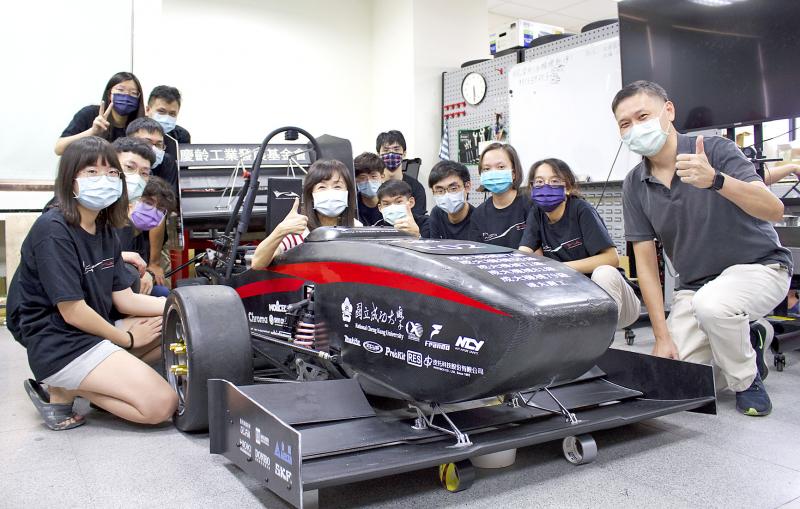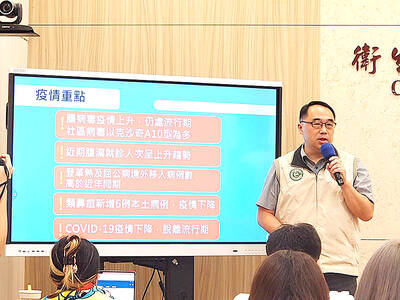Students at National Cheng Kung University (NCKU) have developed the nation’s first electric race car for Formula SAE, which has set speed records with the team’s female driver, it said on Sunday.
Formula SAE is a student design competition organized by SAE International to challenge participants “to conceive, design, fabricate and compete with small formula-style racing cars,” its Web site says.
Teams have eight to 12 months to design, build and prepare their vehicles for a competition, it adds.

Photo courtesy of National Cheng Kung University
Due to the COVID-19 pandemic, more than half of Taiwanese universities did not develop vehicles for the competition, while Japanese schools have not competed in the event for the past two years, the team said.
“Our team was one of a few who made a car during the pandemic, and the only team to make an electric car,” it said. “We hope to enter the competition with it next year.”
The team was particularly proud of their captain, Wu chia-fen (吳佳芬), who set records on the track, it said.
The team’s car this year is the third generation in a series, and cost more than NT$2 million (US$71,390) to make, it said, adding that the team worked on the car for a year.
“We’ve reduced the car’s weight from 340kg in the first generation all the way down to 260kg,” engineering professor Huang Chen-wei (黃晨瑋) said. “We also replaced the single engine with a twin electric motor.”
To compensate for the vehicle’s extra power, the team added an aerodynamic kit, which includes front and rear spoilers, and a skirt, it said.
With the modifications the car is able to go from zero to 100kph in only three seconds, the team said, adding that it also shaved two seconds off its cornering time.
Team member Tseng Chih-chung (曾志仲) said the group strives to improve the car every year, with the aim of securing a good performance record for the nation.
“Due to the pandemic, we had to spend 1.5 times more time this year on our car. Things like electric-motor components and computer chips were scarce,” he said. “We were checking inventory online every day.”
Disease prevention regulations prevented the team from meeting in person for several months, he said, adding that teammates would complete their designs on their own, meet up online and then take turns assembling components at the school.
“It was hard working that way, but in the end we succeeded,” he said.
At a news conference to announce the completion of the vehicle, NCKU president Su Huey-jen (蘇慧貞) named the car “Honor,” adding that the team’s hard work and achievements had brought honor to the university.
Wu, 23, has driven all three generations of the team’s cars.
“When I get in the driver’s seat I like to put the pedal to the metal. I like the sensation of flying down the track at high speed,” she said.
Driving a car that she helped build brought her a great sense of achievement, she added.
Meanwhile, team member Chen Yu-hsien (陳諭嫻) said her test drive of the team’s second-generation vehicle last year was her first time driving a racing car.
The experience was “novel and exciting,” she said.
“Racing cars is something men and women can both do, but women might have the speed advantage given their lighter bodies,” teammate Su Yi-fan (蘇懌帆) said.
The team has about 50 members who work on different aspects of the vehicle, from electric-motor assembly and body to team finances, it said, adding that the members come from different departments at the university.
“The older students pass their experience to the younger ones. Even though we cannot go abroad right now, building this car has really given us a sense of accomplishment,” the team said.
Their next goal is to further improve the vehicle’s design with an eye on competing next year in Japan if the pandemic subsides, the team said.
NCKU is to celebrate its 90th anniversary next month. Anyone who would like to join the celebrations can visit the Web site https://90th.ncku.edu.tw for more information.

A magnitude 4.9 earthquake struck off Tainan at 11:47am today, the Central Weather Administration (CWA) said. The hypocenter was 32.3km northeast of Tainan City Hall at a depth of 7.3km, CWA data showed. The intensity of the quake, which gauges the actual effect of a seismic event, measured 4 in Tainan and Chiayi County on Taiwan's seven-tier intensity scale, the data showed. The quake had an intensity of 3 in Chiayi City and County, and Yunlin County, while it was measured as 2 in Kaohsiung, Nantou County, Changhua County, Taitung County and offshore Penghu County, the data showed. There were no immediate reports of

The Chinese Nationalist Party (KMT) is maintaining close ties with Beijing, the Democratic Progressive Party (DPP) said yesterday, hours after a new round of Chinese military drills in the Taiwan Strait began. Political parties in a democracy have a responsibility to be loyal to the nation and defend its sovereignty, DPP spokesman Justin Wu (吳崢) told a news conference in Taipei. His comments came hours after Beijing announced via Chinese state media that the Chinese People’s Liberation Army’s Eastern Theater Command was holding large-scale drills simulating a multi-pronged attack on Taiwan. Contrary to the KMT’s claims that it is staunchly anti-communist, KMT Deputy

RESPONSE: The government would investigate incidents of Taiwanese entertainers in China promoting CCP propaganda online in contravention of the law, the source said Taiwanese entertainers living in China who are found to have contravened cross-strait regulations or collaborated with the Chinese Communist Party (CCP) could be subject to fines, a source said on Sunday. Several Taiwanese entertainers have posted on the social media platform Sina Weibo saying that Taiwan “must be returned” to China, and sharing news articles from Chinese state media. In response, the Mainland Affairs Council (MAC) has asked the Ministry of Culture to investigate whether the entertainers had contravened any laws, and asked for them to be questioned upon their return to Taiwan, an official familiar with the matter said. To curb repeated

Taiwan has recorded its first fatal case of Coxsackie B5 enterovirus in 10 years after a one-year-old boy from southern Taiwan died from complications early last month, the Centers for Disease Control (CDC) said yesterday. CDC spokesman Lo Yi-chun (羅一鈞) told a news conference that the child initially developed a fever and respiratory symptoms before experiencing seizures and loss of consciousness. The boy was diagnosed with acute encephalitis and admitted to intensive care, but his condition deteriorated rapidly, and he passed away on the sixth day of illness, Lo said. This also marks Taiwan’s third enterovirus-related death this year and the first severe